ISY00243 Case Study Report: Analyzing Natural-Lee Farm Systems
VerifiedAdded on 2022/08/15
|17
|2466
|34
Report
AI Summary
This report, a case study for ISY00243 at Southern Cross University, analyzes the manual farm management system of Natural-Lee and proposes an automated system. It begins with an introduction highlighting the shift from manual to automated systems in the farming industry, followed by a discussion of fact-finding techniques, including questionnaires and interviews. The report details a use case diagram with brief and full use case descriptions, including 'Order products,' 'View payroll details,' and 'Manage user accounts.' It presents an activity diagram, an ERD, and sample data to illustrate the system's functionality. A system sequence diagram and a discussion of software packages, specifically ERP systems like Oracle ERP cloud and NetSuite ERP, are included. The report concludes with recommendations for implementing the ERP system, emphasizing the importance of change management, employee training, and risk analysis. The bibliography lists relevant sources on ERP system implementation and performance.
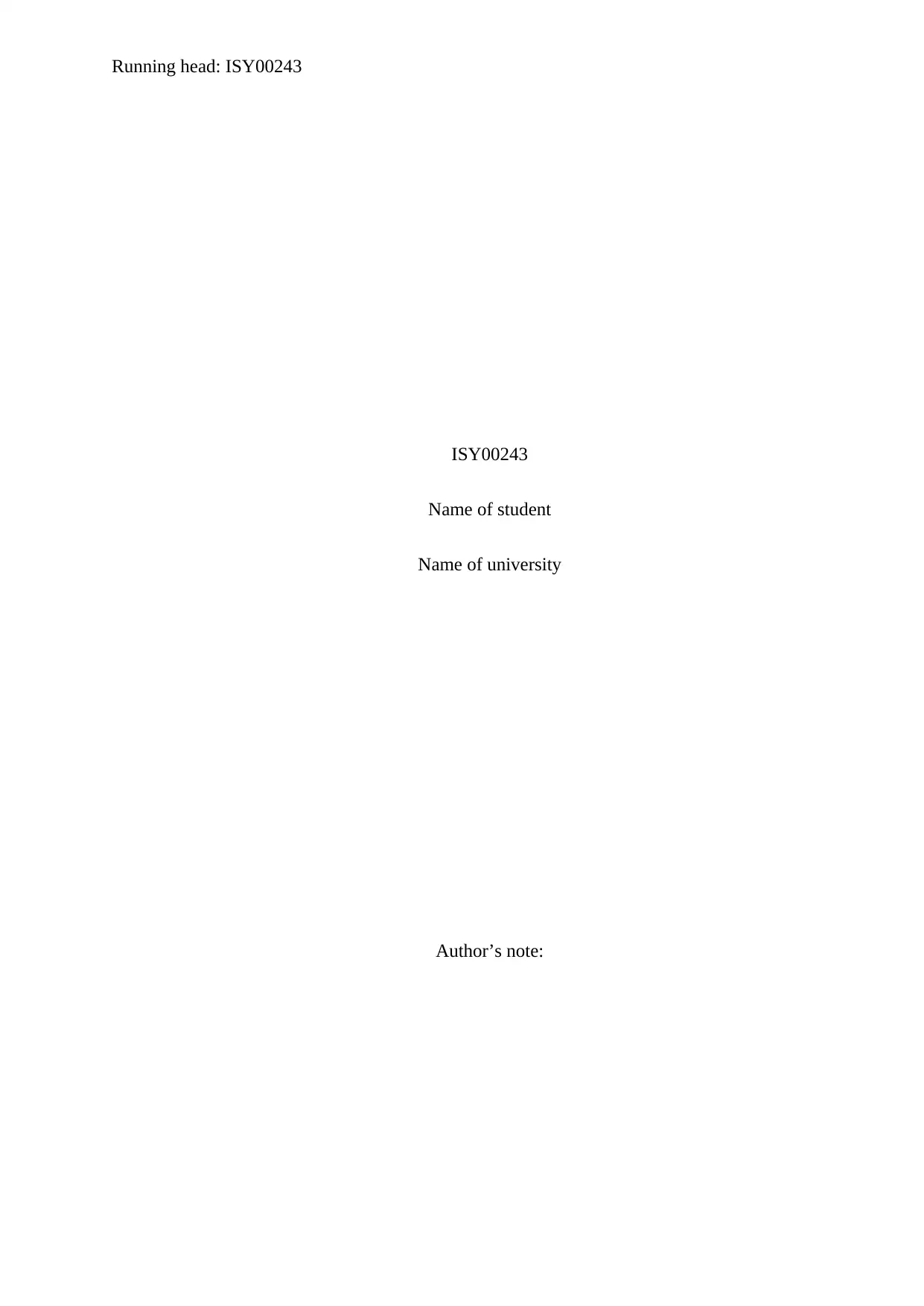
Running head: ISY00243
ISY00243
Name of student
Name of university
Author’s note:
ISY00243
Name of student
Name of university
Author’s note:
Paraphrase This Document
Need a fresh take? Get an instant paraphrase of this document with our AI Paraphraser
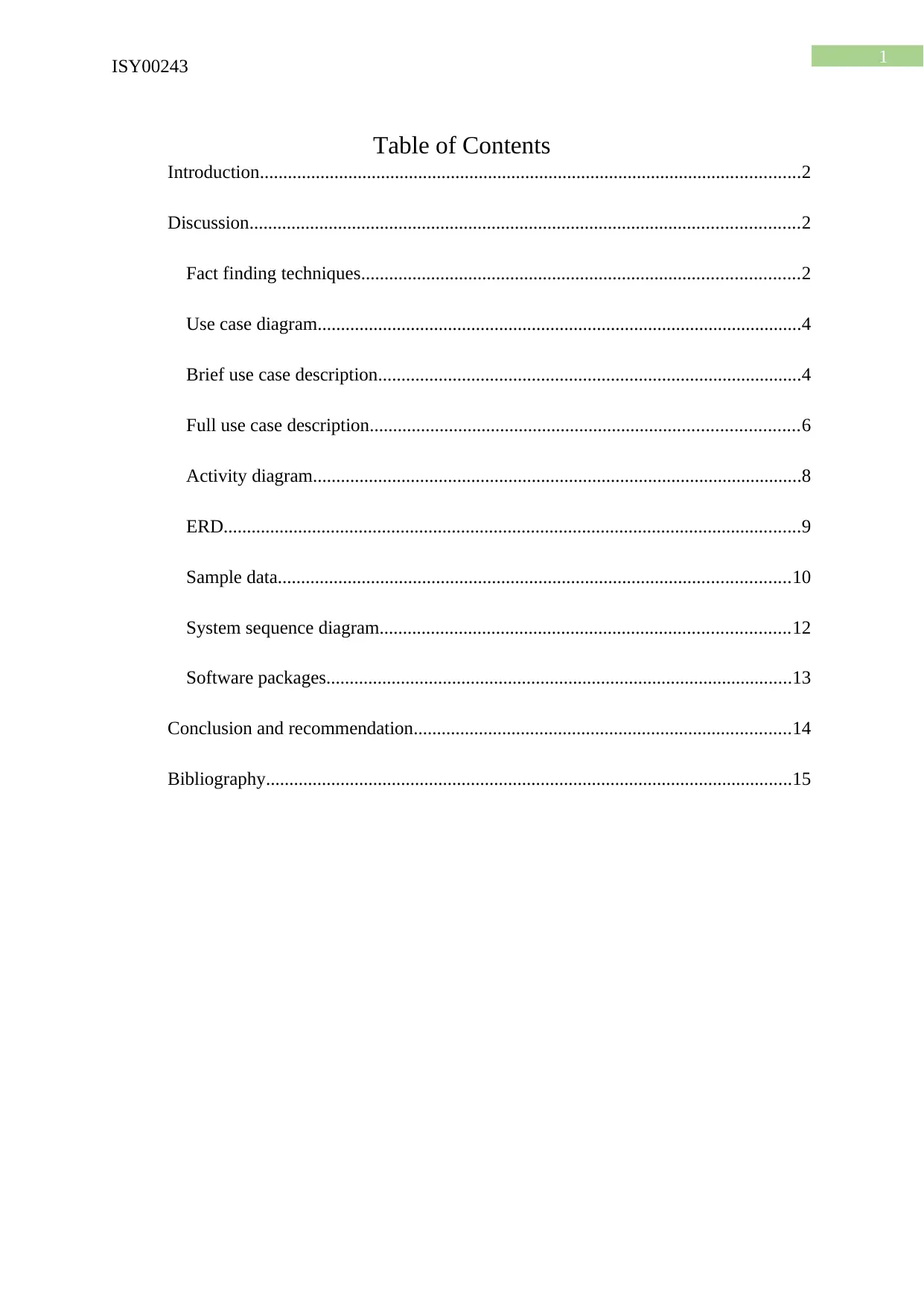
1
ISY00243
Table of Contents
Introduction....................................................................................................................2
Discussion......................................................................................................................2
Fact finding techniques..............................................................................................2
Use case diagram........................................................................................................4
Brief use case description...........................................................................................4
Full use case description............................................................................................6
Activity diagram.........................................................................................................8
ERD............................................................................................................................9
Sample data..............................................................................................................10
System sequence diagram........................................................................................12
Software packages....................................................................................................13
Conclusion and recommendation.................................................................................14
Bibliography.................................................................................................................15
ISY00243
Table of Contents
Introduction....................................................................................................................2
Discussion......................................................................................................................2
Fact finding techniques..............................................................................................2
Use case diagram........................................................................................................4
Brief use case description...........................................................................................4
Full use case description............................................................................................6
Activity diagram.........................................................................................................8
ERD............................................................................................................................9
Sample data..............................................................................................................10
System sequence diagram........................................................................................12
Software packages....................................................................................................13
Conclusion and recommendation.................................................................................14
Bibliography.................................................................................................................15
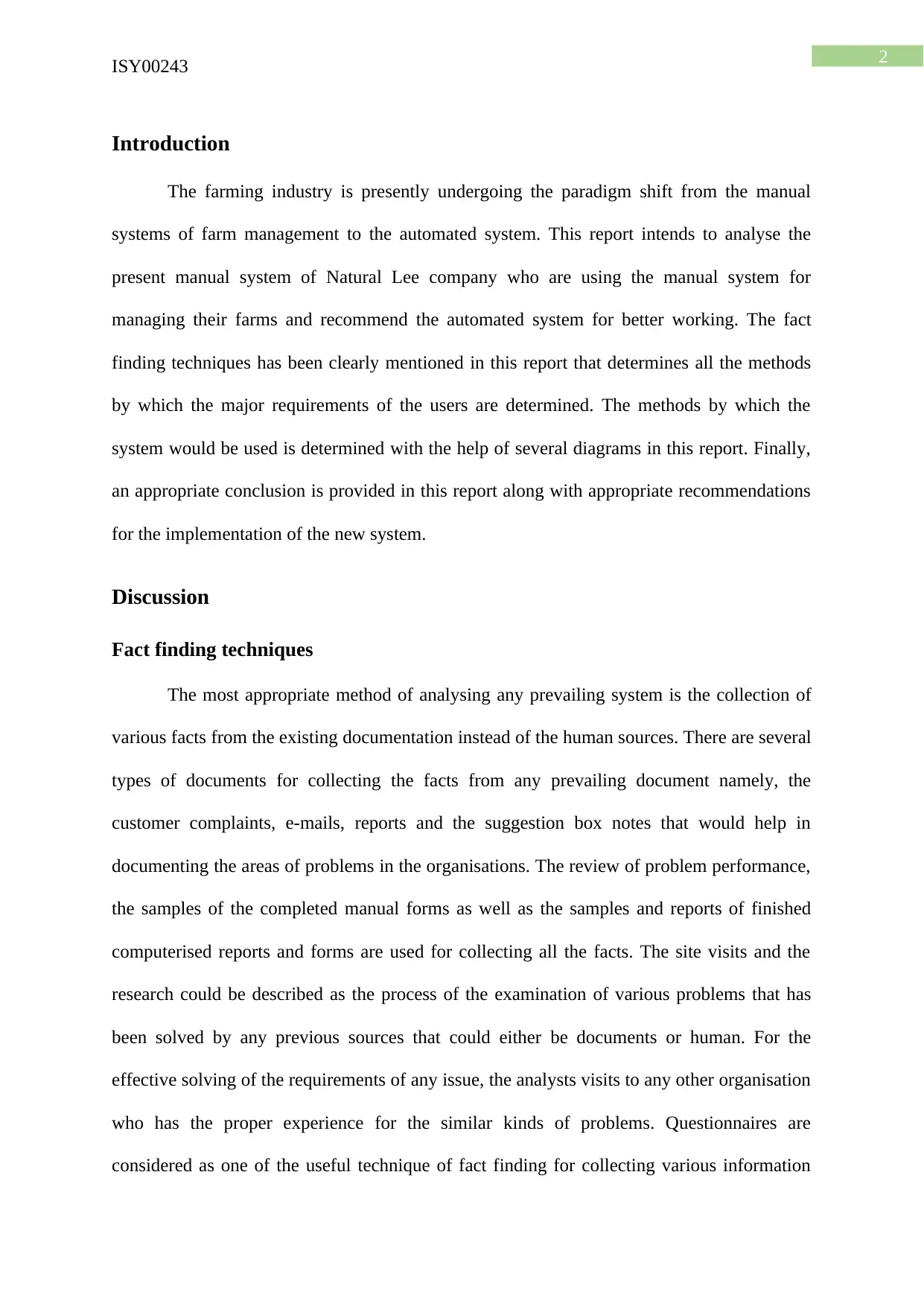
2
ISY00243
Introduction
The farming industry is presently undergoing the paradigm shift from the manual
systems of farm management to the automated system. This report intends to analyse the
present manual system of Natural Lee company who are using the manual system for
managing their farms and recommend the automated system for better working. The fact
finding techniques has been clearly mentioned in this report that determines all the methods
by which the major requirements of the users are determined. The methods by which the
system would be used is determined with the help of several diagrams in this report. Finally,
an appropriate conclusion is provided in this report along with appropriate recommendations
for the implementation of the new system.
Discussion
Fact finding techniques
The most appropriate method of analysing any prevailing system is the collection of
various facts from the existing documentation instead of the human sources. There are several
types of documents for collecting the facts from any prevailing document namely, the
customer complaints, e-mails, reports and the suggestion box notes that would help in
documenting the areas of problems in the organisations. The review of problem performance,
the samples of the completed manual forms as well as the samples and reports of finished
computerised reports and forms are used for collecting all the facts. The site visits and the
research could be described as the process of the examination of various problems that has
been solved by any previous sources that could either be documents or human. For the
effective solving of the requirements of any issue, the analysts visits to any other organisation
who has the proper experience for the similar kinds of problems. Questionnaires are
considered as one of the useful technique of fact finding for collecting various information
ISY00243
Introduction
The farming industry is presently undergoing the paradigm shift from the manual
systems of farm management to the automated system. This report intends to analyse the
present manual system of Natural Lee company who are using the manual system for
managing their farms and recommend the automated system for better working. The fact
finding techniques has been clearly mentioned in this report that determines all the methods
by which the major requirements of the users are determined. The methods by which the
system would be used is determined with the help of several diagrams in this report. Finally,
an appropriate conclusion is provided in this report along with appropriate recommendations
for the implementation of the new system.
Discussion
Fact finding techniques
The most appropriate method of analysing any prevailing system is the collection of
various facts from the existing documentation instead of the human sources. There are several
types of documents for collecting the facts from any prevailing document namely, the
customer complaints, e-mails, reports and the suggestion box notes that would help in
documenting the areas of problems in the organisations. The review of problem performance,
the samples of the completed manual forms as well as the samples and reports of finished
computerised reports and forms are used for collecting all the facts. The site visits and the
research could be described as the process of the examination of various problems that has
been solved by any previous sources that could either be documents or human. For the
effective solving of the requirements of any issue, the analysts visits to any other organisation
who has the proper experience for the similar kinds of problems. Questionnaires are
considered as one of the useful technique of fact finding for collecting various information
⊘ This is a preview!⊘
Do you want full access?
Subscribe today to unlock all pages.

Trusted by 1+ million students worldwide
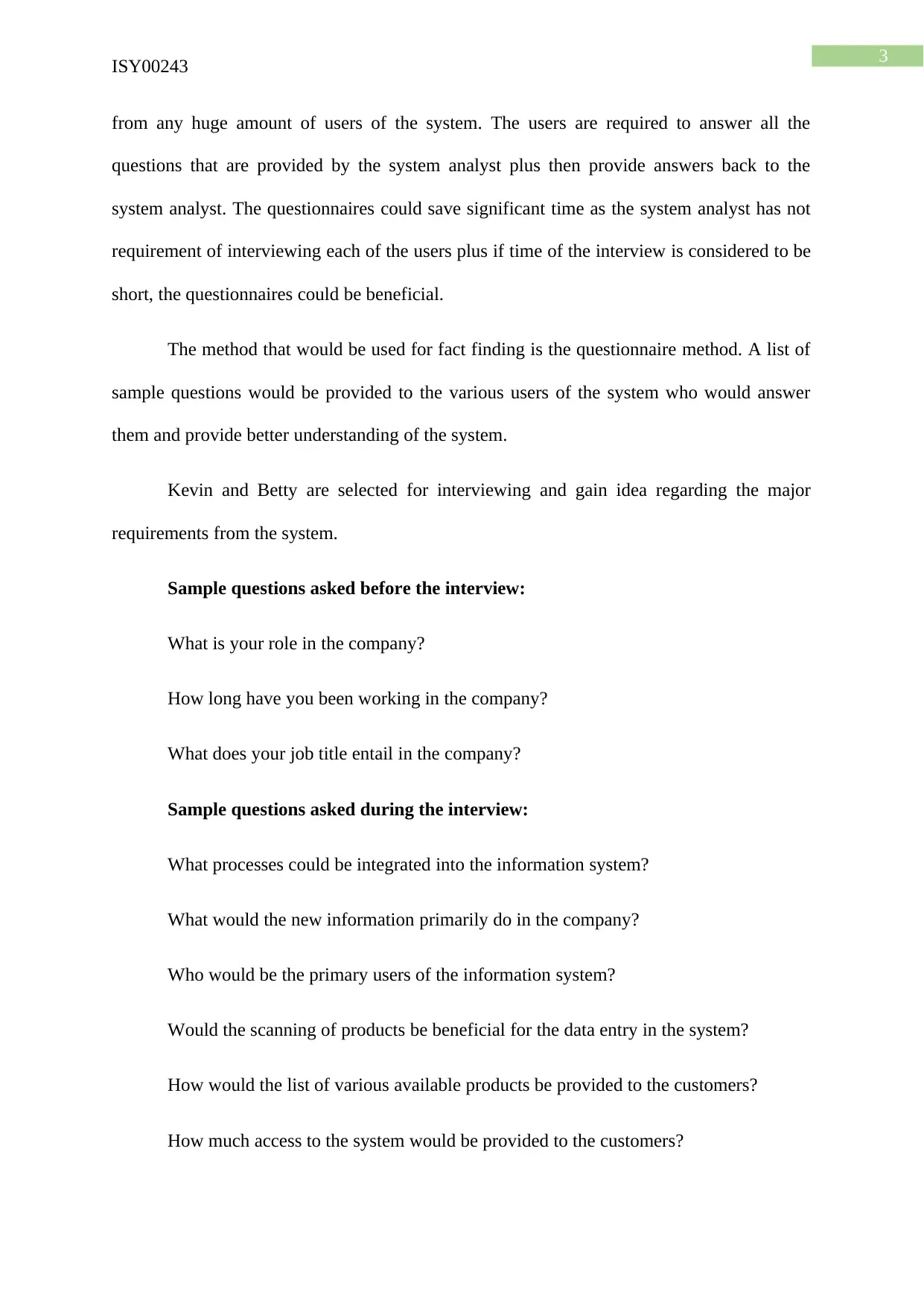
3
ISY00243
from any huge amount of users of the system. The users are required to answer all the
questions that are provided by the system analyst plus then provide answers back to the
system analyst. The questionnaires could save significant time as the system analyst has not
requirement of interviewing each of the users plus if time of the interview is considered to be
short, the questionnaires could be beneficial.
The method that would be used for fact finding is the questionnaire method. A list of
sample questions would be provided to the various users of the system who would answer
them and provide better understanding of the system.
Kevin and Betty are selected for interviewing and gain idea regarding the major
requirements from the system.
Sample questions asked before the interview:
What is your role in the company?
How long have you been working in the company?
What does your job title entail in the company?
Sample questions asked during the interview:
What processes could be integrated into the information system?
What would the new information primarily do in the company?
Who would be the primary users of the information system?
Would the scanning of products be beneficial for the data entry in the system?
How would the list of various available products be provided to the customers?
How much access to the system would be provided to the customers?
ISY00243
from any huge amount of users of the system. The users are required to answer all the
questions that are provided by the system analyst plus then provide answers back to the
system analyst. The questionnaires could save significant time as the system analyst has not
requirement of interviewing each of the users plus if time of the interview is considered to be
short, the questionnaires could be beneficial.
The method that would be used for fact finding is the questionnaire method. A list of
sample questions would be provided to the various users of the system who would answer
them and provide better understanding of the system.
Kevin and Betty are selected for interviewing and gain idea regarding the major
requirements from the system.
Sample questions asked before the interview:
What is your role in the company?
How long have you been working in the company?
What does your job title entail in the company?
Sample questions asked during the interview:
What processes could be integrated into the information system?
What would the new information primarily do in the company?
Who would be the primary users of the information system?
Would the scanning of products be beneficial for the data entry in the system?
How would the list of various available products be provided to the customers?
How much access to the system would be provided to the customers?
Paraphrase This Document
Need a fresh take? Get an instant paraphrase of this document with our AI Paraphraser
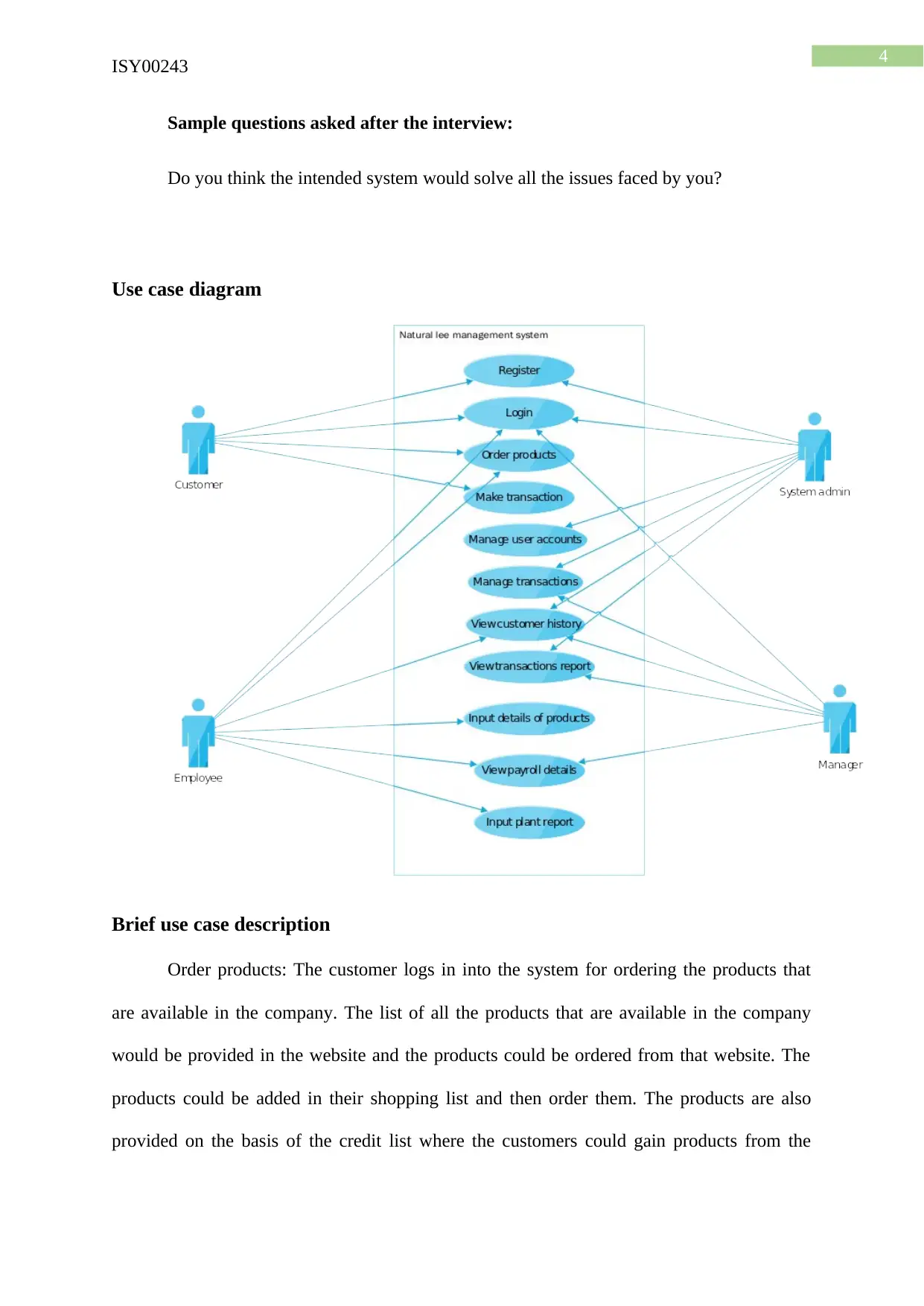
4
ISY00243
Sample questions asked after the interview:
Do you think the intended system would solve all the issues faced by you?
Use case diagram
Brief use case description
Order products: The customer logs in into the system for ordering the products that
are available in the company. The list of all the products that are available in the company
would be provided in the website and the products could be ordered from that website. The
products could be added in their shopping list and then order them. The products are also
provided on the basis of the credit list where the customers could gain products from the
ISY00243
Sample questions asked after the interview:
Do you think the intended system would solve all the issues faced by you?
Use case diagram
Brief use case description
Order products: The customer logs in into the system for ordering the products that
are available in the company. The list of all the products that are available in the company
would be provided in the website and the products could be ordered from that website. The
products could be added in their shopping list and then order them. The products are also
provided on the basis of the credit list where the customers could gain products from the
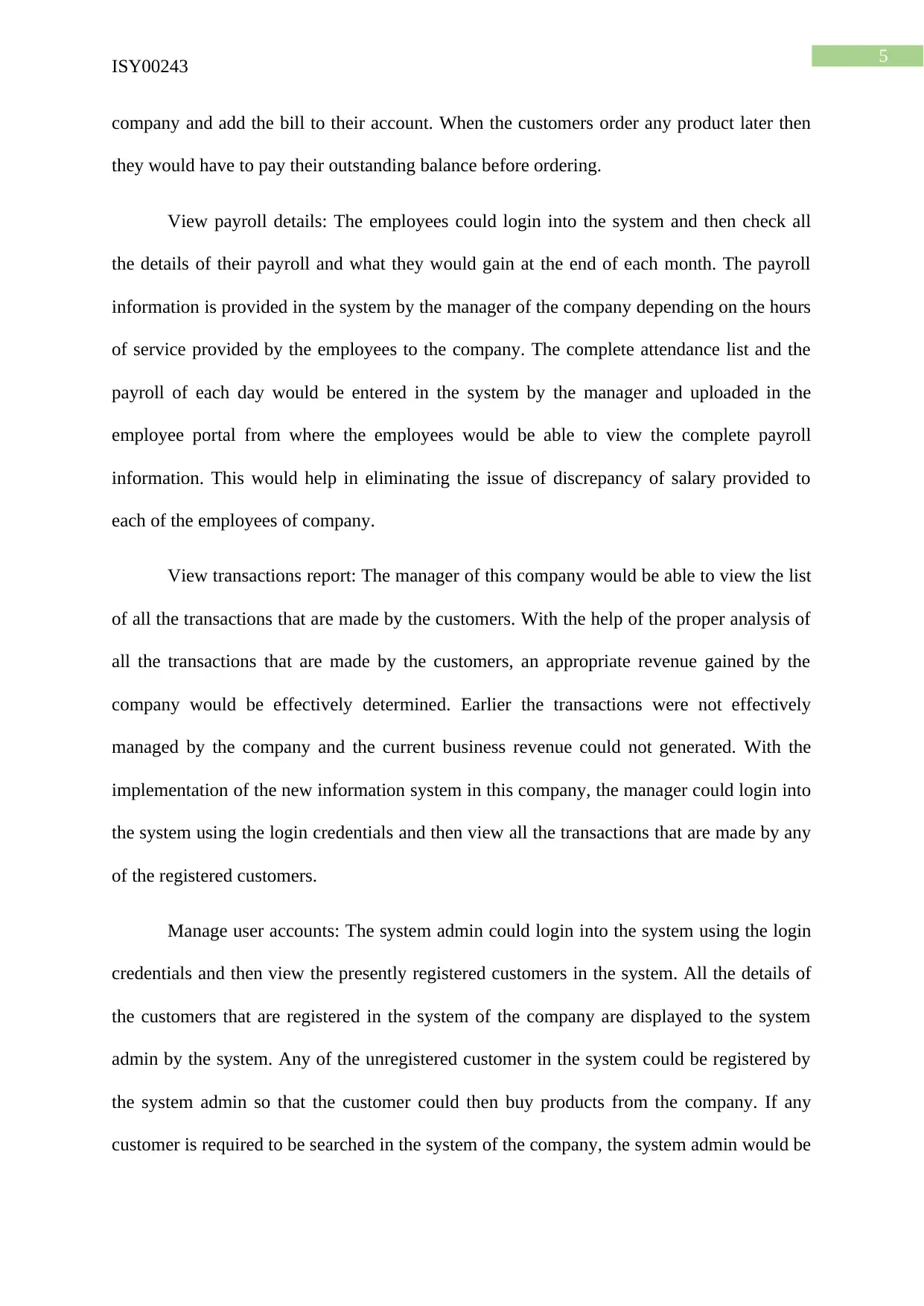
5
ISY00243
company and add the bill to their account. When the customers order any product later then
they would have to pay their outstanding balance before ordering.
View payroll details: The employees could login into the system and then check all
the details of their payroll and what they would gain at the end of each month. The payroll
information is provided in the system by the manager of the company depending on the hours
of service provided by the employees to the company. The complete attendance list and the
payroll of each day would be entered in the system by the manager and uploaded in the
employee portal from where the employees would be able to view the complete payroll
information. This would help in eliminating the issue of discrepancy of salary provided to
each of the employees of company.
View transactions report: The manager of this company would be able to view the list
of all the transactions that are made by the customers. With the help of the proper analysis of
all the transactions that are made by the customers, an appropriate revenue gained by the
company would be effectively determined. Earlier the transactions were not effectively
managed by the company and the current business revenue could not generated. With the
implementation of the new information system in this company, the manager could login into
the system using the login credentials and then view all the transactions that are made by any
of the registered customers.
Manage user accounts: The system admin could login into the system using the login
credentials and then view the presently registered customers in the system. All the details of
the customers that are registered in the system of the company are displayed to the system
admin by the system. Any of the unregistered customer in the system could be registered by
the system admin so that the customer could then buy products from the company. If any
customer is required to be searched in the system of the company, the system admin would be
ISY00243
company and add the bill to their account. When the customers order any product later then
they would have to pay their outstanding balance before ordering.
View payroll details: The employees could login into the system and then check all
the details of their payroll and what they would gain at the end of each month. The payroll
information is provided in the system by the manager of the company depending on the hours
of service provided by the employees to the company. The complete attendance list and the
payroll of each day would be entered in the system by the manager and uploaded in the
employee portal from where the employees would be able to view the complete payroll
information. This would help in eliminating the issue of discrepancy of salary provided to
each of the employees of company.
View transactions report: The manager of this company would be able to view the list
of all the transactions that are made by the customers. With the help of the proper analysis of
all the transactions that are made by the customers, an appropriate revenue gained by the
company would be effectively determined. Earlier the transactions were not effectively
managed by the company and the current business revenue could not generated. With the
implementation of the new information system in this company, the manager could login into
the system using the login credentials and then view all the transactions that are made by any
of the registered customers.
Manage user accounts: The system admin could login into the system using the login
credentials and then view the presently registered customers in the system. All the details of
the customers that are registered in the system of the company are displayed to the system
admin by the system. Any of the unregistered customer in the system could be registered by
the system admin so that the customer could then buy products from the company. If any
customer is required to be searched in the system of the company, the system admin would be
⊘ This is a preview!⊘
Do you want full access?
Subscribe today to unlock all pages.

Trusted by 1+ million students worldwide
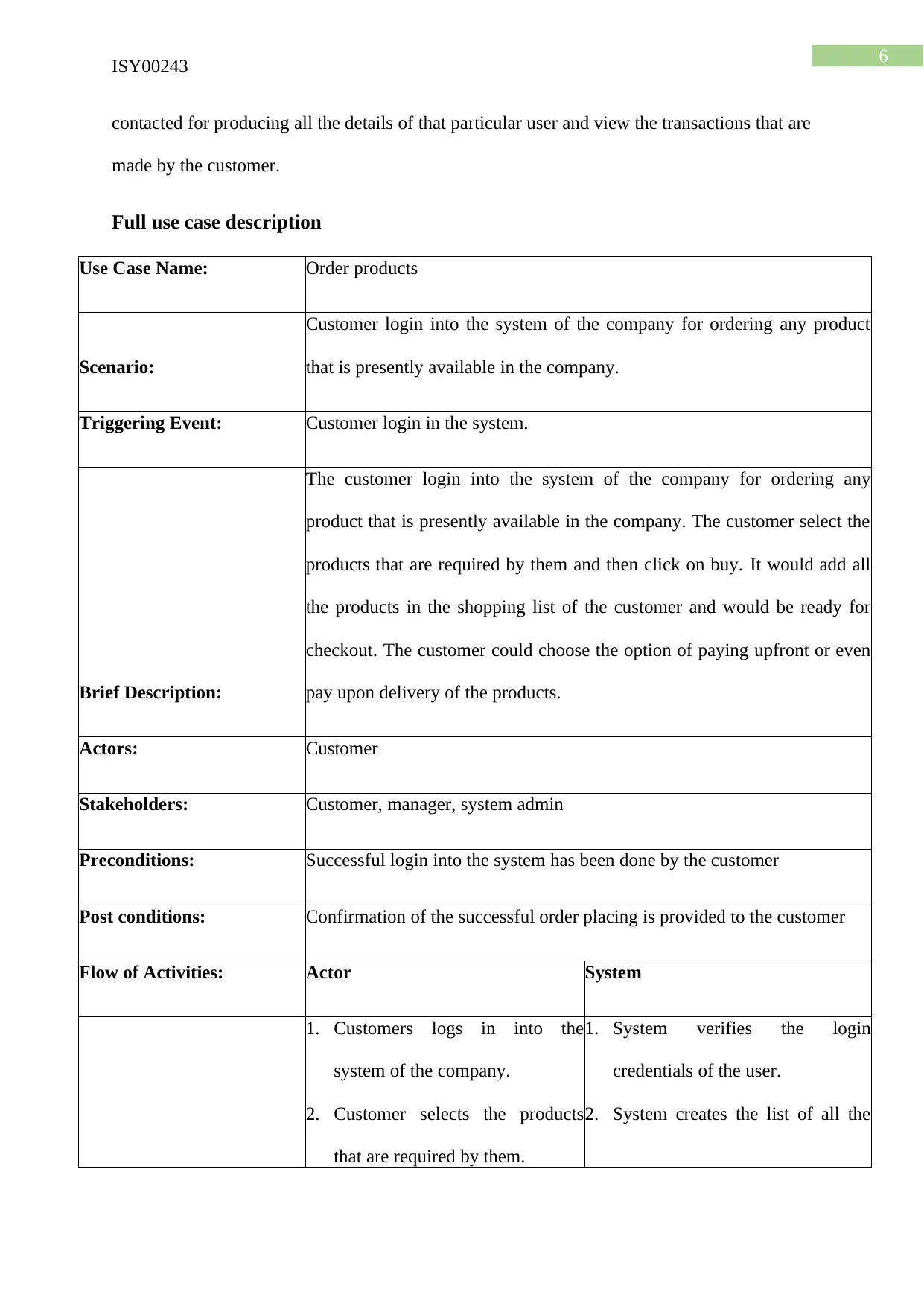
6
ISY00243
contacted for producing all the details of that particular user and view the transactions that are
made by the customer.
Full use case description
Use Case Name: Order products
Scenario:
Customer login into the system of the company for ordering any product
that is presently available in the company.
Triggering Event: Customer login in the system.
Brief Description:
The customer login into the system of the company for ordering any
product that is presently available in the company. The customer select the
products that are required by them and then click on buy. It would add all
the products in the shopping list of the customer and would be ready for
checkout. The customer could choose the option of paying upfront or even
pay upon delivery of the products.
Actors: Customer
Stakeholders: Customer, manager, system admin
Preconditions: Successful login into the system has been done by the customer
Post conditions: Confirmation of the successful order placing is provided to the customer
Flow of Activities: Actor System
1. Customers logs in into the
system of the company.
2. Customer selects the products
that are required by them.
1. System verifies the login
credentials of the user.
2. System creates the list of all the
ISY00243
contacted for producing all the details of that particular user and view the transactions that are
made by the customer.
Full use case description
Use Case Name: Order products
Scenario:
Customer login into the system of the company for ordering any product
that is presently available in the company.
Triggering Event: Customer login in the system.
Brief Description:
The customer login into the system of the company for ordering any
product that is presently available in the company. The customer select the
products that are required by them and then click on buy. It would add all
the products in the shopping list of the customer and would be ready for
checkout. The customer could choose the option of paying upfront or even
pay upon delivery of the products.
Actors: Customer
Stakeholders: Customer, manager, system admin
Preconditions: Successful login into the system has been done by the customer
Post conditions: Confirmation of the successful order placing is provided to the customer
Flow of Activities: Actor System
1. Customers logs in into the
system of the company.
2. Customer selects the products
that are required by them.
1. System verifies the login
credentials of the user.
2. System creates the list of all the
Paraphrase This Document
Need a fresh take? Get an instant paraphrase of this document with our AI Paraphraser
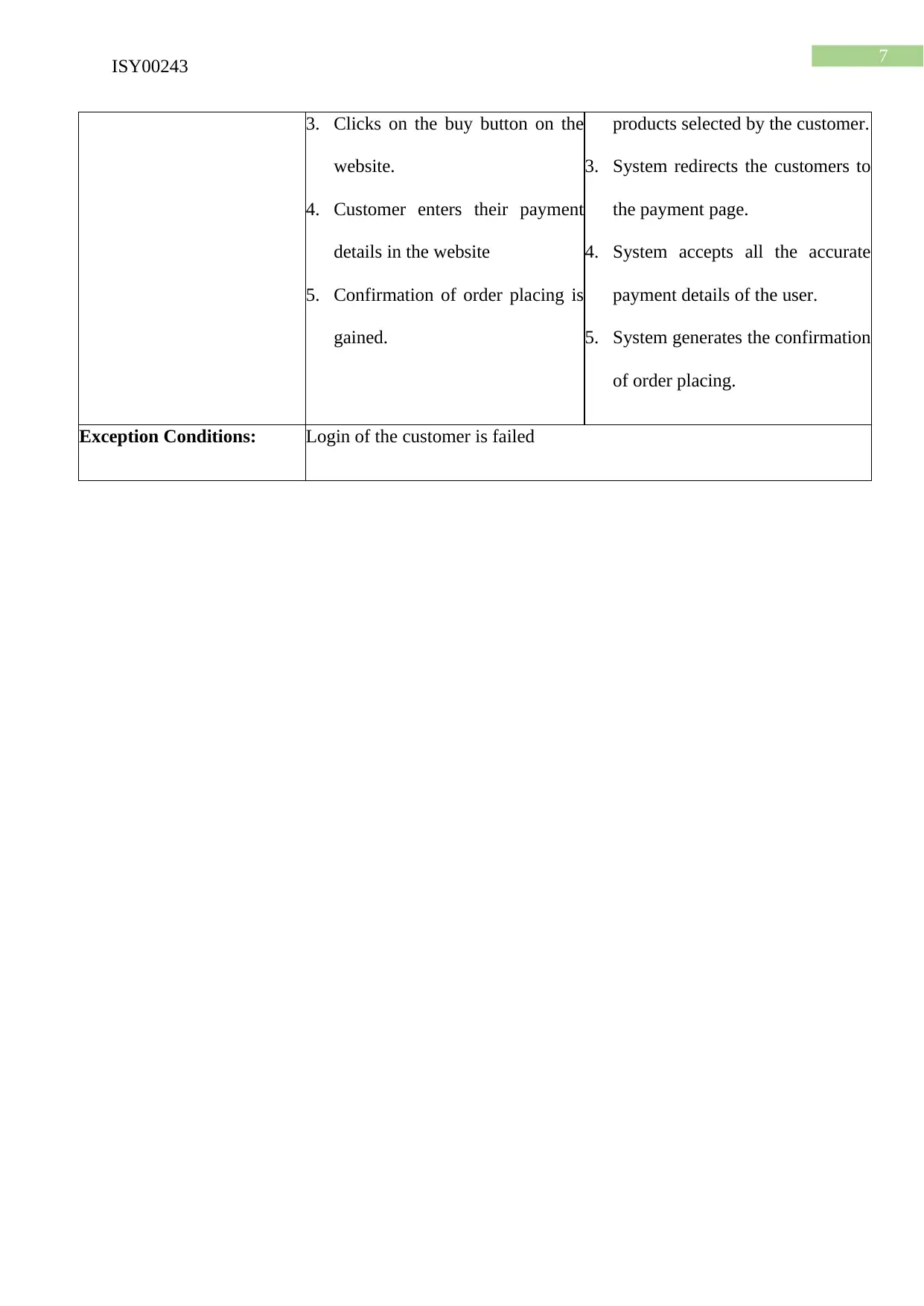
7
ISY00243
3. Clicks on the buy button on the
website.
4. Customer enters their payment
details in the website
5. Confirmation of order placing is
gained.
products selected by the customer.
3. System redirects the customers to
the payment page.
4. System accepts all the accurate
payment details of the user.
5. System generates the confirmation
of order placing.
Exception Conditions: Login of the customer is failed
ISY00243
3. Clicks on the buy button on the
website.
4. Customer enters their payment
details in the website
5. Confirmation of order placing is
gained.
products selected by the customer.
3. System redirects the customers to
the payment page.
4. System accepts all the accurate
payment details of the user.
5. System generates the confirmation
of order placing.
Exception Conditions: Login of the customer is failed
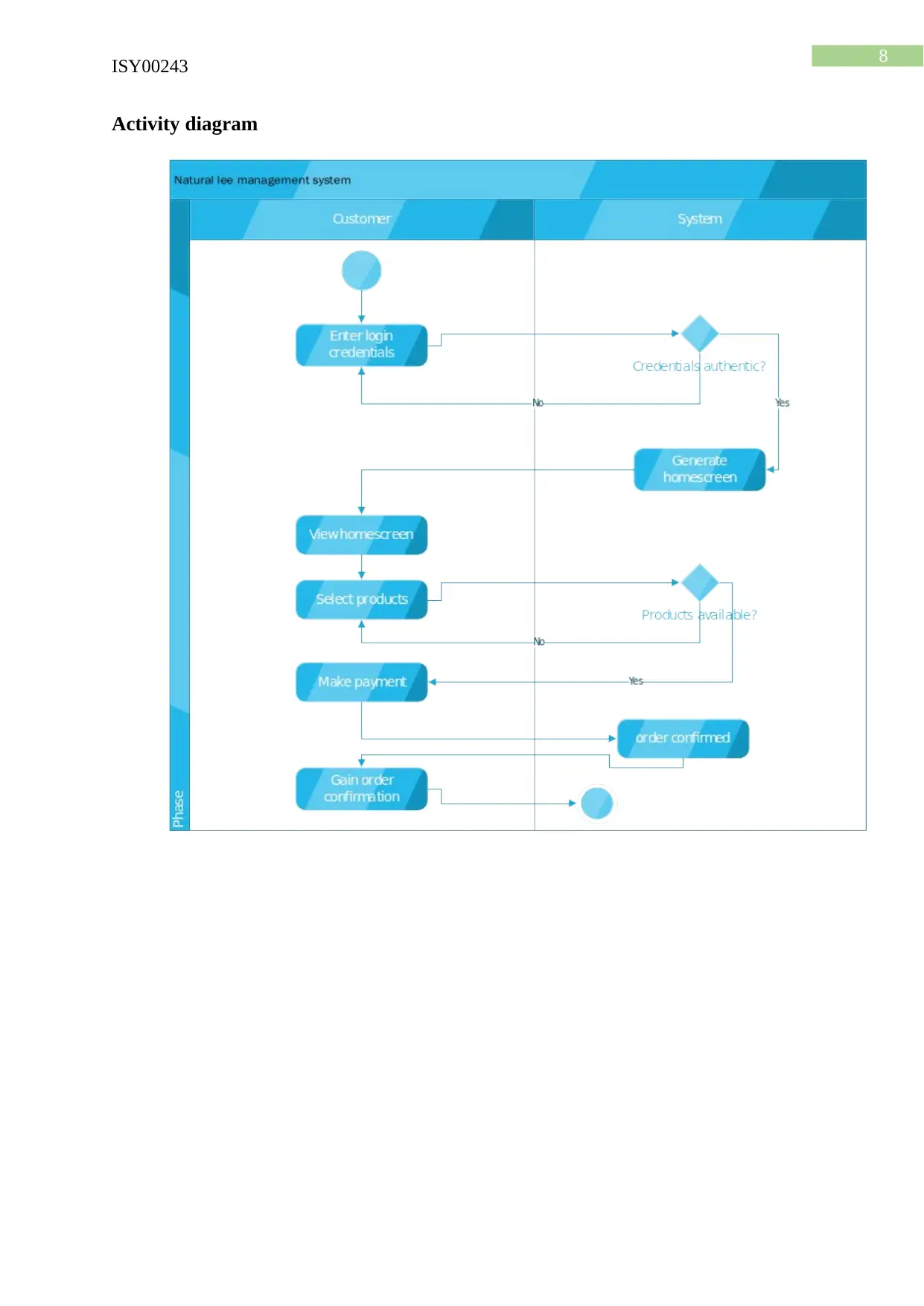
8
ISY00243
Activity diagram
ISY00243
Activity diagram
⊘ This is a preview!⊘
Do you want full access?
Subscribe today to unlock all pages.

Trusted by 1+ million students worldwide
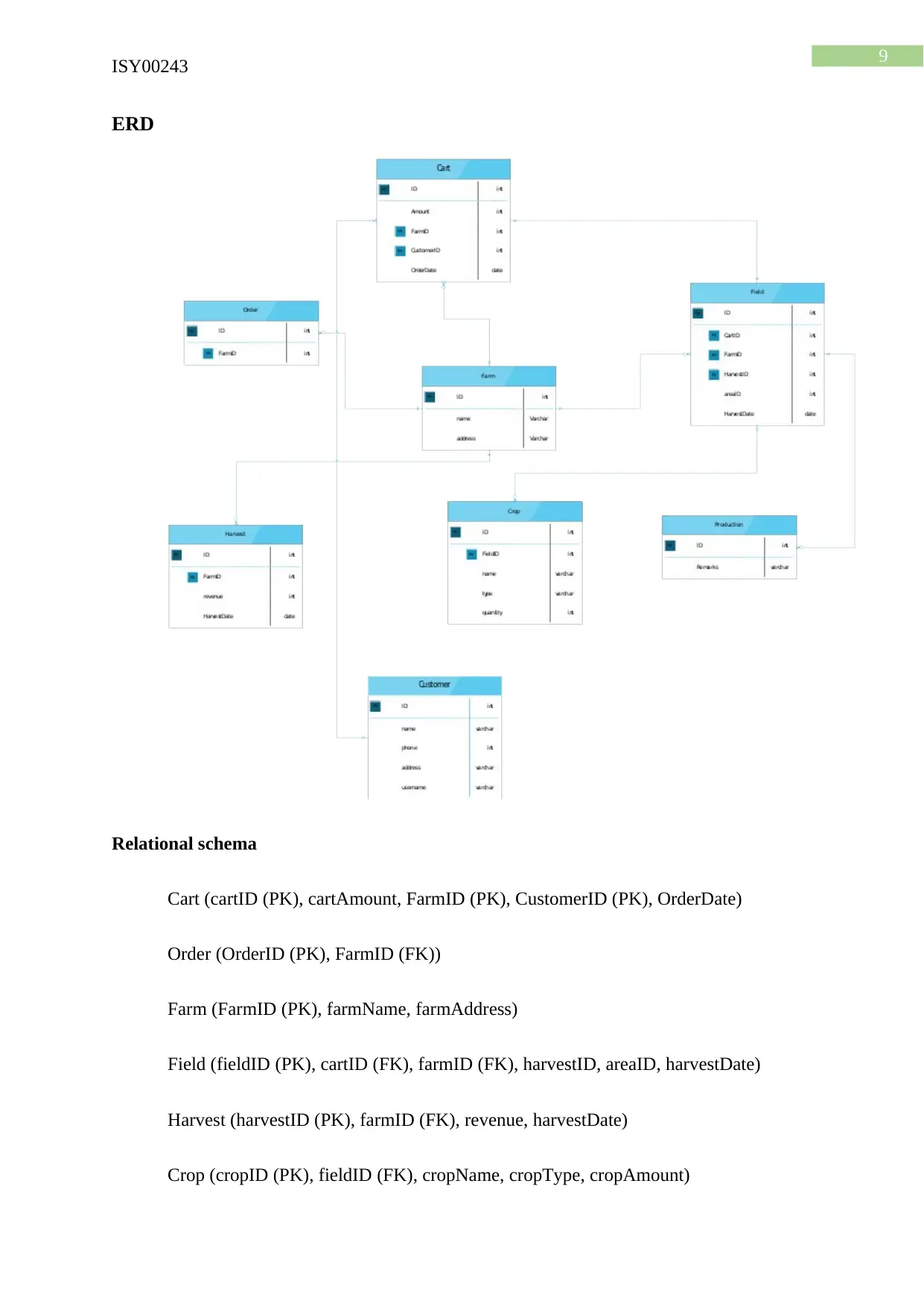
9
ISY00243
ERD
Relational schema
Cart (cartID (PK), cartAmount, FarmID (PK), CustomerID (PK), OrderDate)
Order (OrderID (PK), FarmID (FK))
Farm (FarmID (PK), farmName, farmAddress)
Field (fieldID (PK), cartID (FK), farmID (FK), harvestID, areaID, harvestDate)
Harvest (harvestID (PK), farmID (FK), revenue, harvestDate)
Crop (cropID (PK), fieldID (FK), cropName, cropType, cropAmount)
ISY00243
ERD
Relational schema
Cart (cartID (PK), cartAmount, FarmID (PK), CustomerID (PK), OrderDate)
Order (OrderID (PK), FarmID (FK))
Farm (FarmID (PK), farmName, farmAddress)
Field (fieldID (PK), cartID (FK), farmID (FK), harvestID, areaID, harvestDate)
Harvest (harvestID (PK), farmID (FK), revenue, harvestDate)
Crop (cropID (PK), fieldID (FK), cropName, cropType, cropAmount)
Paraphrase This Document
Need a fresh take? Get an instant paraphrase of this document with our AI Paraphraser
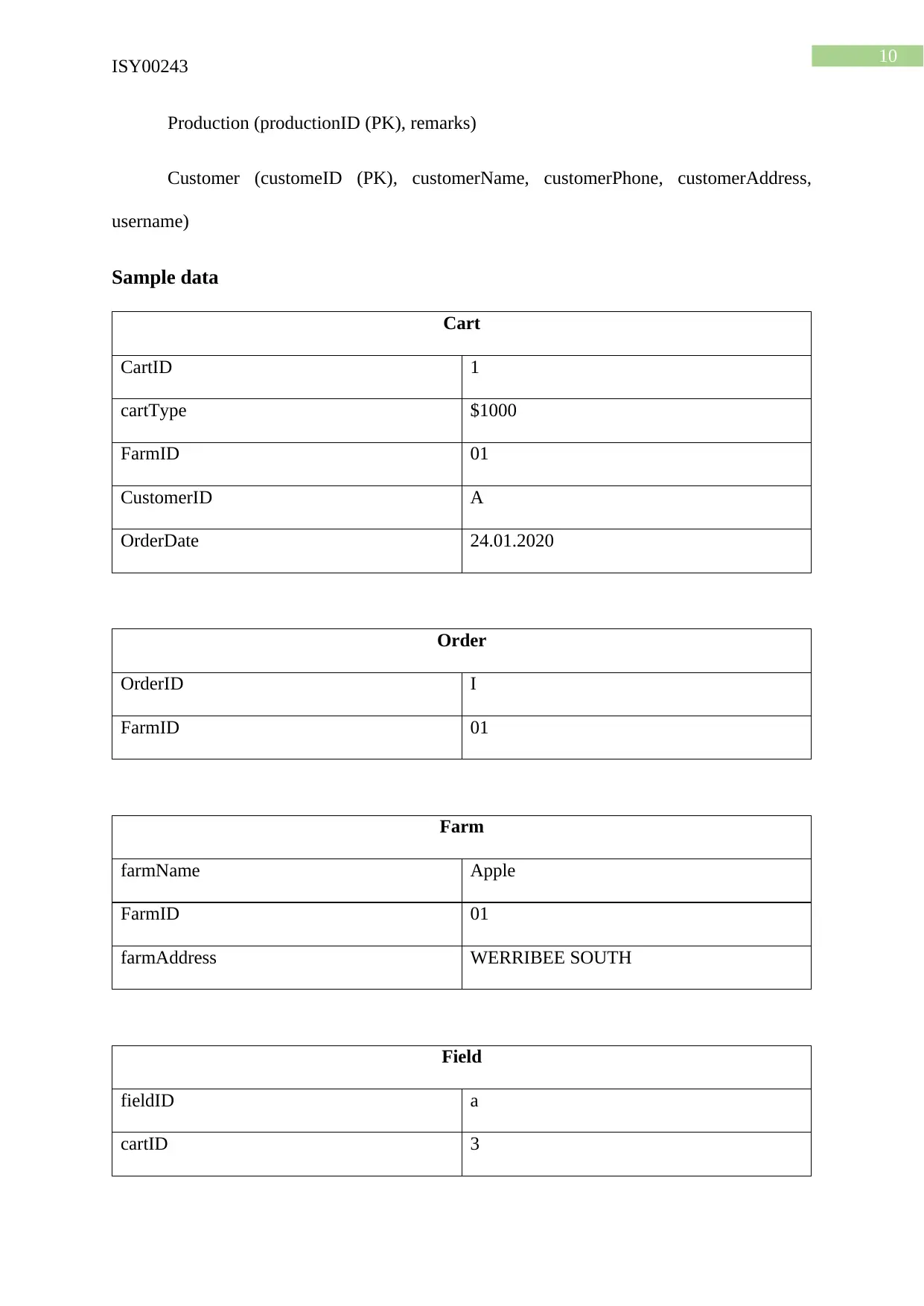
10
ISY00243
Production (productionID (PK), remarks)
Customer (customeID (PK), customerName, customerPhone, customerAddress,
username)
Sample data
Cart
CartID 1
cartType $1000
FarmID 01
CustomerID A
OrderDate 24.01.2020
Order
OrderID I
FarmID 01
Farm
farmName Apple
FarmID 01
farmAddress WERRIBEE SOUTH
Field
fieldID a
cartID 3
ISY00243
Production (productionID (PK), remarks)
Customer (customeID (PK), customerName, customerPhone, customerAddress,
username)
Sample data
Cart
CartID 1
cartType $1000
FarmID 01
CustomerID A
OrderDate 24.01.2020
Order
OrderID I
FarmID 01
Farm
farmName Apple
FarmID 01
farmAddress WERRIBEE SOUTH
Field
fieldID a
cartID 3
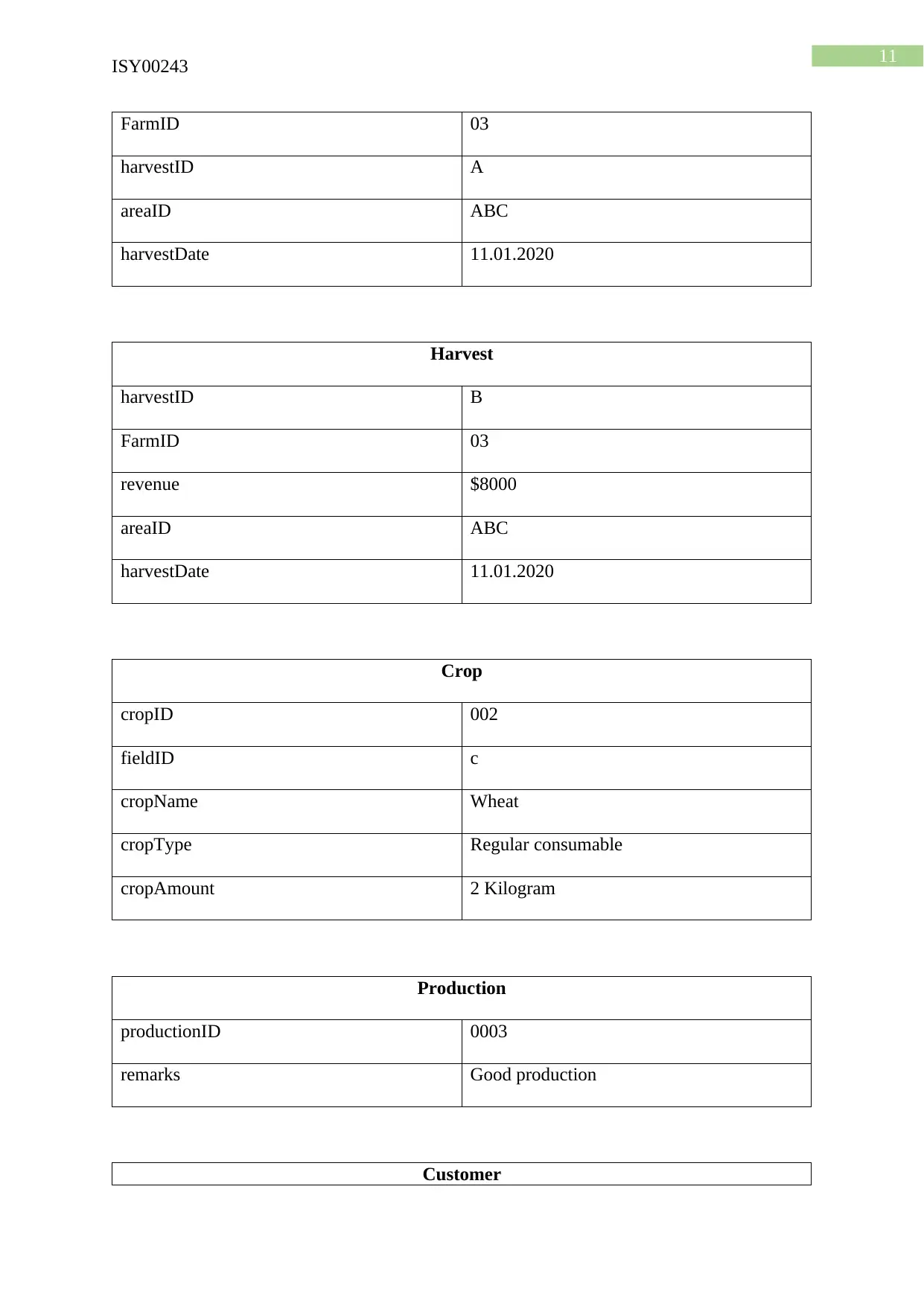
11
ISY00243
FarmID 03
harvestID A
areaID ABC
harvestDate 11.01.2020
Harvest
harvestID B
FarmID 03
revenue $8000
areaID ABC
harvestDate 11.01.2020
Crop
cropID 002
fieldID c
cropName Wheat
cropType Regular consumable
cropAmount 2 Kilogram
Production
productionID 0003
remarks Good production
Customer
ISY00243
FarmID 03
harvestID A
areaID ABC
harvestDate 11.01.2020
Harvest
harvestID B
FarmID 03
revenue $8000
areaID ABC
harvestDate 11.01.2020
Crop
cropID 002
fieldID c
cropName Wheat
cropType Regular consumable
cropAmount 2 Kilogram
Production
productionID 0003
remarks Good production
Customer
⊘ This is a preview!⊘
Do you want full access?
Subscribe today to unlock all pages.

Trusted by 1+ million students worldwide
1 out of 17
Related Documents
Your All-in-One AI-Powered Toolkit for Academic Success.
+13062052269
info@desklib.com
Available 24*7 on WhatsApp / Email
![[object Object]](/_next/static/media/star-bottom.7253800d.svg)
Unlock your academic potential
Copyright © 2020–2025 A2Z Services. All Rights Reserved. Developed and managed by ZUCOL.




